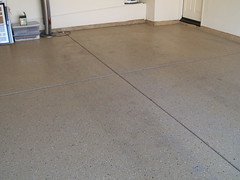One of the biggest improvements one can make to their garage is to recondition the floor… or in the case of new construction, to do something to protect the floor. Let’s run over a few options…
- Floor paint. Just don’t do it. The first time you drive into the garage, the paint will peel off of the floor. It might be ok for basements or other areas that aren’t going to see garage type use, but floor paint just doesn’t cut it for the garage.
- Floor Epoxy. Definitely better than floor paint. Most of these are two part epoxies that form a chemical and mechanical bond with the concrete. There are a couple of things to keep in mind, though. The first is that the bottom of the slab needs to have a moisture barrier (tape a square piece of plastic down on the floor for a couple of da
 ys and see if moisture forms under the plastic) and the prep is VERY important. In addition to chemical etching, many opt to also “shot-blast” the floor with a specific machine. The removes all traces of oil and leaves the right amount of texture to get the best adhesion.
ys and see if moisture forms under the plastic) and the prep is VERY important. In addition to chemical etching, many opt to also “shot-blast” the floor with a specific machine. The removes all traces of oil and leaves the right amount of texture to get the best adhesion.
- Definitely use the flakes or other traction adding additive… slippery when wet!
- Be careful with jack stands and floor jacks. They can damage the floor.
- Cover the bottom couple of inches of the wall… hose out the floor when dirty.
- Polished concrete. Looks great. Many Home Depot and Lowe’s stores do this. It is smooth and strong. It is also slippery when wet. It is usually sealed.
- Sealed concrete. This is also quite tough. It will stand up to tools, but may be resealing occasionally. If it is well sealed, oil or other liquids won’t soak in and stain. It may also be slippery.
Obviously there are different solutions that will work better for different people. There are also variations with each of the options.
With polished and/or sealed concrete, there are techniques to color stain and acid wash it. It can look like polished marble or have a color pattern. Epoxy also can be color designed. It can be varied by base coat and flakes. Done right, it can look like a very nice granite.
Tools can also be modified to extend the utility of the flooring. One great example is to weld a flat plate to the bottom of jack stands. Th e edges and corners are smoothed, and a rubber sheet attached to the bottom. This prevents scoring the floor with the stands. Floor jacks are tougher to alter. Changing the wheels is tough. Most come with steel wheels, and it would be tough to find a urethane or rubber wheel that could stand up to the weight. An aluminum wheel might do the trick, but I haven’t tested it.
